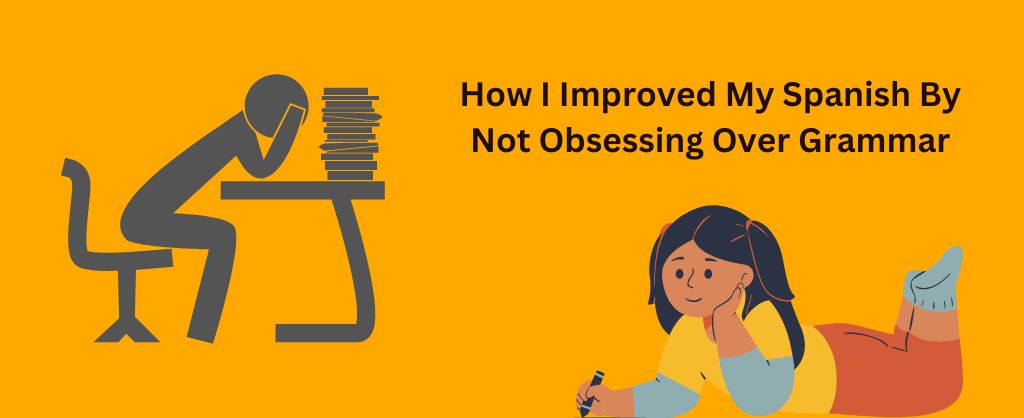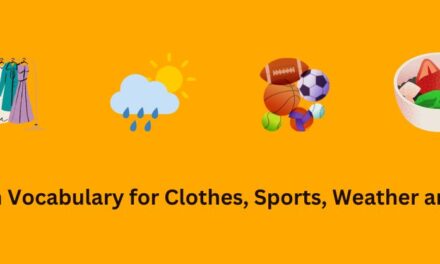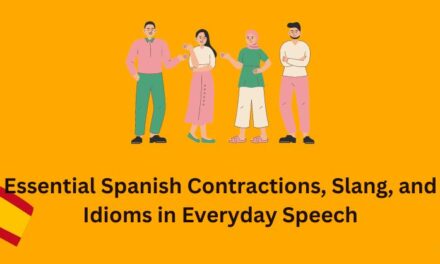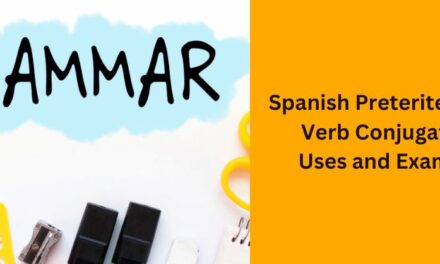How I Improved My Spanish By Not Obsessing Over Grammar

Learning a new language can be pretty frustrating and hard sometimes. Especially when you have to memorize a ton of grammar rules. I started enjoying Spanish a lot more once I changed my approach.
My Early Attempts at Learning Spanish
I’ve always been fascinated by languages, so when I decided to pick up Spanish a few years ago, I dove in enthusiastically. I started out strong – I printed out verb conjugation charts, made flashcards for vocabulary lists, and even bought a huge textbook on Spanish grammar.
Armed with all these materials, I tried to tackle Spanish in an academic, rigorous way. I drilled verb conjugations, memorized rules about when to use ser vs estar, and tried to learn all the nuances of noun and adjective agreement.
This studying worked well at first. I felt like I was making steady progress as I gained more grammar knowledge. But after a few months, I started to feel burnt out.
Speaking Spanish began to feel more like taking a test than having a conversation. I knew how to analyze sentence structure, but I struggled to understand native speakers.
Hitting a Plateau with the Textbook Approach
After hitting this plateau, I realized focusing so much on textbook Spanish wasn’t helping me become fluent. I could ace written grammar tests, but I lacked conversational confidence. Spanish started to feel like a chore rather than something fun.
I knew most native speakers didn’t consciously think about grammar rules when chatting with friends or going about their daily lives. So why was I agonizing over obscure subjunctive clauses and irregular past participles?
At this point, I took a step back to reevaluate my approach. I still wanted to improve my Spanish, but I needed a way to study that felt more natural and intuitive.
Shifting Focus to Vocabulary Building
Rather than dense grammar textbooks, I started reading more books, magazines, and news articles in Spanish. Instead of memorizing verb charts, I focused on expanding my vocabulary.
When I learned a new word, I’d make flashcards and practice using it in different conversational contexts.
This method allowed me to naturally pick up grammar patterns along the way. The more Spanish content I read and listened to, the more my brain internalized the rhythms of the language. Instead of learning rules in isolation, I absorbed them in real-world examples.
As my vocabulary grew, so did my confidence. I could understand more spoken Spanish, which led me to watch TV shows and YouTube videos in Spanish. Being able to follow along with native speakers gave me a major boost of motivation.
Immersing Myself in the Spanish Language
Once I focused less on textbook studying, I was able to have more fun actively immersing myself in the language. Every day I tried to surround myself with as much Spanish as possible.
I started reading news articles from Spanish-language websites every morning with my coffee. I listened to Spanish music while cleaning the house and driving. I watched cooking tutorials from Spanish-speaking chefs on YouTube.
When I talked to my Mexican friends, I asked them to only speak in Spanish so I could practice conversing.
This full immersion gave me a better intuitive grasp of the language than any textbook. After a few months, I was able to have short, casual conversations in Spanish without agonizing over proper grammar. I picked up on slang terms and cultural references that enhanced my comprehension.
Did this mean I completely quit studying grammar? Not at all. I still worked on improving grammatical areas I struggled with the most. But it no longer felt like the primary focus.
Using Grammar Study to Supplement Real-World Practice
While vocabulary building through immersion became my priority, targeted grammar study served as a supplement when needed. If I noticed I was making the same grammar mistakes repeatedly in conversation, I’d do some extra drills. But I focused only on the problem areas relevant to my current skill level.
For example, I drilled present tense verb conjugation a lot in the beginning. Later I realized I mixed up ser and estar frequently, so I studied rules on when to use each one. Recently I noticed I struggle with imperfect vs preterite past tense, so that’s my current grammar focus.
This targeted approach prevented grammar from feeling overwhelming. I was able to zero in on concepts that would provide the most benefit.
Studying became more streamlined once I identified my weak spots through real-world interactions.
Staying Motivated by Tracking Small Wins
Learning a language takes time and consistency. To stay motivated, I kept a journal where I logged Spanish study sessions and small wins. Seeing tangible progress kept me from getting discouraged.
I wrote down vocabulary words mastered, new grammatical concepts grasped, and instances where I successfully conversed in Spanish. Looking back at early journal entries, I could see clear improvement. Sentences became more complex, vocabulary expanded, and grammar mistakes decreased.
Seeing visible progress towards fluency maintained my motivation on difficult days. I knew slip-ups were inevitable, but the overall trajectory was positive if I kept pushing myself. Logging wins made the larger goal of fluency feel less insurmountable.
Connecting with Other Language Learners
In addition to tracking my own progress, finding a community also boosted motivation. I joined online forums where I could connect with other language learners. Seeing their successes, frustrations, tips and questions made me feel less alone in the process.
I also met several local Spanish learners for a weekly conversación group at a coffee shop. We motivated each other to only speak Spanish during meetings. Practicing in a relaxed social setting made me less self-conscious about mistakes. Having a regular commitment encouraged me to keep making progress between meetings.
Setting Goals
An important way I stayed motivated was setting tangible goals to work towards. Early on, I aimed to hold a 5-minute Spanish conversation and understand a short news article.
Later goals included reading a book in Spanish and expressing opinions on abstract topics. Having milestone markers on the horizon focused my studying.
Why Fluency Requires Flexibility
What my journey has taught me is that there is no single “right” way to learn a language. Fluency requires flexibility, self-awareness and a willingness to adjust approaches over time.
For me, letting go of rigid grammar structures was the breakthrough I needed. But continual grammar study works well for many dedicated learners. There are also those who pick up language intuitively without any textbook study.
The key is tailoring strategies to your unique strengths, weaknesses and interests. This adaptability prevents learning from becoming a chore.
Stay curious, notice when frustration creeps in, and make changes to reengage yourself. Persistence and a passion for connection will carry you through the inevitable ups and downs.
Conclusion
My long and winding road to Spanish fluency has had many twists and turns. But the overall trajectory continues pointing upward when I focus on big-picture motivation, surround myself with the language, and balance grammar study with real-world practice.
Learning Spanish grammar will always be part of my journey – I’m certainly not done yet! But keeping grammar in perspective allows me to enjoy the ride. By taking the pressure off perfection, I’ve found a path that feels more sustainable.
For anyone feeling frustrated or burdened by grammar study, I encourage you to shift focus toward vocabulary building through immersion. Find native content you genuinely enjoy and let grammar come along for the ride. Structure studying around your goals and interests to stay engaged.
Most importantly, remember that language learning should open doors to new experiences. It takes time, but the rewards of connection make the effort worthwhile.









